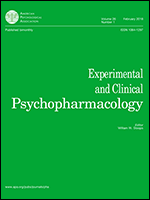 “Changes in the regulation of endocannabinoid production, together with an altered expression of their receptors are hallmarks of cancer, including colorectal cancer (CRC). Although several studies have been conducted to understand the biological role of the CB1 receptor in cancer, little is known about its involvement in the metastatic process of CRC. The aim of this study was to investigate the possible link between CB1 receptor expression and the presence of metastasis in patients with CRC, investigating the main signaling pathways elicited downstream of CB1 receptor in colon cancer. Fifty-nine consecutive patients, with histologically proven colorectal cancer, were enrolled in the study, of which 30 patients with synchronous metastasis, at first diagnosis and 29 without metastasis. A low expression of CB1 receptor were detected in primary tumor tissue of CRC patients with metastasis and consequently, we observed an alteration of CB1 receptor downstream signaling. These signaling routes were also altered in intestinal normal mucosa, suggesting that, normal mucosa surrounding the tumor provides a realistic picture of the molecules involved in tissue malignant transformation. These observations contribute to the idea that drugs able to induce CB1 receptor expression can be helpful in order to set new anticancer therapeutic strategies.”
“Changes in the regulation of endocannabinoid production, together with an altered expression of their receptors are hallmarks of cancer, including colorectal cancer (CRC). Although several studies have been conducted to understand the biological role of the CB1 receptor in cancer, little is known about its involvement in the metastatic process of CRC. The aim of this study was to investigate the possible link between CB1 receptor expression and the presence of metastasis in patients with CRC, investigating the main signaling pathways elicited downstream of CB1 receptor in colon cancer. Fifty-nine consecutive patients, with histologically proven colorectal cancer, were enrolled in the study, of which 30 patients with synchronous metastasis, at first diagnosis and 29 without metastasis. A low expression of CB1 receptor were detected in primary tumor tissue of CRC patients with metastasis and consequently, we observed an alteration of CB1 receptor downstream signaling. These signaling routes were also altered in intestinal normal mucosa, suggesting that, normal mucosa surrounding the tumor provides a realistic picture of the molecules involved in tissue malignant transformation. These observations contribute to the idea that drugs able to induce CB1 receptor expression can be helpful in order to set new anticancer therapeutic strategies.”
Monthly Archives: May 2019
Endocannabinoid System in Hepatic Glucose Metabolism, Fatty Liver Disease, and Cirrhosis.

“There is growing evidence that glucose metabolism in the liver is in part under the control of the endocannabinoid system (ECS) which is also supported by its presence in this organ. The ECS consists of its cannabinoid receptors (CBRs) and enzymes that are responsible for endocannabinoid production and metabolism. ECS is known to be differentially influenced by the hepatic glucose metabolism and insulin resistance, e.g., cannabinoid receptor type 1(CB1) antagonist can improve the glucose tolerance and insulin resistance. Interestingly, our own study shows that expression patterns of CBRs are influenced by the light/dark cycle, which is of significant physiological and clinical interest. The ECS system is highly upregulated during chronic liver disease and a growing number of studies suggest a mechanistic and therapeutic impact of ECS on the development of liver fibrosis, especially putting its receptors into focus. An opposing effect of the CBRs was exerted via the CB1 or CB2 receptor stimulation. An activation of CB1promoted fibrogenesis, while CB2 activation improved antifibrogenic responses. However, underlying mechanisms are not yet clear. In the context of liver diseases, the ECS is considered as a possible mediator, which seems to be involved in the synthesis of fibrotic tissue, increase of intrahepatic vascular resistance and subsequently development of portal hypertension. Portal hypertension is the main event that leads to complications of the disease. The main complication is the development of variceal bleeding and ascites, which have prognostic relevance for the patients. The present review summarizes the current understanding and impact of the ECS on glucose metabolism in the liver, in association with the development of liver cirrhosis and hemodynamics in cirrhosis and its complication, to give perspectives for development of new therapeutic strategies.”
[Medicinal cannabis].

“The use of cannabis products for medical purposes is rapidly increasing in the Netherlands. Studies suggest that these products have positive effects in the treatment of chronic neuropathic pain, multiple-sclerosis-related spasticity, certain epilepsy syndromes and chemotherapy-related nausea and vomiting.”
Age-related differences in Δ⁹-tetrahydrocannabinol-induced antinociception in female and male rats.

“Given the use of cannabis as an analgesic by a broadening age range of patients, the aim of this study was to determine whether the antinociceptive effects of Δ9-tetrahydrocannabinol (THC) differ by age.
On the tail withdrawal test, THC was significantly more effective in middle-aged adult than in young adult rats and significantly less effective in adolescent than in young adult rats.
Sex differences in THC’s antinociceptive effects were consistent across the 3 ages examined, with greater THC effects observed in females than males of each age. Age-related differences in THC’s locomotor-suppressing effect were also observed, with the greatest effect in young adult female rats. Serum THC levels were slightly higher in adolescent than in young adult rats, and levels of the active metabolites 11-OH-THC and cannabinol, as well as the inactive metabolite 11-nor-9-carboxy-THC, did not differ between adolescent and young adult rats.
These results suggest that the pain-relieving effects of THC may be more limited in adolescents than in adults and that these age-related differences in THC effect are not attributable to differential absorption or metabolism of THC.”
Cannabis use disorder and suicide attempts in bipolar disorder: A meta-analysis.

“We aimed at clarifying the strength and consistency of the association between cannabis use disorder and suicide attempts in bipolar disorder.
We could not perform a meta-analysis exploring the longitudinal association between cannabis use disorder and suicide attempts, due to the lack of suitable data.
The current evidence highlights a weak association between cannabis use disorder and suicidal attempts in bipolar disorder.
Due to the cross-sectional design of included studies, causal inferences could not be explored.”
https://www.ncbi.nlm.nih.gov/pubmed/31121199
https://www.sciencedirect.com/science/article/pii/S014976341830993X?via%3Dihub
Effects of cannabidiol on alcohol-related outcomes: A review of preclinical and human research.

“This article reviews preclinical and human studies examining the effects of CBD administration on alcohol responses. Preliminary preclinical results suggest that CBD can attenuate alcohol consumption and potentially protect against certain harmful effects of alcohol, such as liver and brain damage.”
The New Runner’s High? Examining Relationships Between Cannabis Use and Exercise Behavior in States With Legalized Cannabis.

“Scientific literature examining cannabis use in the context of health behaviors, such as exercise engagement, is extremely sparse and has yielded inconsistent findings. This issue is becoming increasingly relevant as cannabis legalization continues, a situation that has been associated with increased initiation of use among adults, and increased potency of available products in legalized states.
Physical activity is among the most important health behaviors, but many Americans do not meet minimum exercise recommendations for healthy living. Common issues surrounding low exercise rates include inadequate enjoyment of and motivation to exercise, and poor recovery from exercise.
It is unclear whether cannabis use shortly before and/or after exercise impacts these issues, and whether this co-use affects exercise performance. The present online survey study examines attitudes and behaviors regarding cannabis use with exercise among adult cannabis users living in states with full legal access (N = 605).
Results indicated that the majority (81.7%) of participants endorsed using cannabis concurrently with exercise, and those who did tended to be younger and more likely to be males (p < 0.0005 for both). Even after controlling for these differences, co-users reported engaging in more minutes of aerobic and anaerobic exercise per week (p < 0.01 and p < 0.05, respectively). In addition, the majority of participants who endorsed using cannabis shortly before/after exercise reported that doing so enhances their enjoyment of and recovery from exercise, and approximately half reported that it increases their motivation to exercise.
This study represents an important step in clarifying cannabis use with exercise among adult users in states with legal cannabis markets, and provides guidance for future research directions.”
“A runner’s high depends on cannabinoid receptors in mice.” http://www.ncbi.nlm.nih.gov/pubmed/26438875
“Wired to run: exercise-induced endocannabinoid signaling in humans and cursorial mammals with implications for the ‘runner’s high’” http://jeb.biologists.org/content/215/8/1331.long
Cannabinoid Attenuation of Intestinal Inflammation in Chronic SIV-Infected Rhesus Macaques Involves T Cell Modulation and Differential Expression of Micro-RNAs and Pro-inflammatory Genes.

“Cannabis use is frequent in HIV-infected individuals for its appetite stimulation and anti-inflammatory effects. To identify the underlying molecular mechanisms associated with these effects, we simultaneously profiled micro-RNA (miRNA) and mRNA expression in the colon of chronically simian immunodeficiency virus (SIV)-infected rhesus macaques administered either vehicle (VEH/SIV; n = 9) or Δ9-tetrahydrocannabinol (Δ9-THC; THC/SIV; n = 8).
Pro-inflammatory miR-130a, miR-222, and miR-29b, lipopolysaccharide-responsive miR-146b-5p and SIV-induced miR-190b were significantly upregulated in VEH/SIV rhesus macaques. Compared to VEH/SIV rhesus macaques, 10 miRNAs were significantly upregulated in THC/SIV rhesus macaques, among which miR-204 was confirmed to directly target MMP8, an extracellular matrix-degrading collagenase that was significantly downregulated in THC/SIV rhesus macaques. Moreover, THC/SIV rhesus macaques failed to upregulate pro-inflammatory miR-21, miR-141 and miR-222, and alpha/beta-defensins, suggesting attenuated intestinal inflammation.
Further, THC/SIV rhesus macaques showed higher expression of tight junction proteins (occludin, claudin-3), anti-inflammatory MUC13, keratin-8 (stress protection), PROM1 (epithelial proliferation), and anti-HIV CCL5. Gomori one-step trichrome staining detected significant collagen deposition (fibrosis) in the paracortex and B cell follicular zones of axillary lymph nodes from all VEH/SIV but not in THC/SIV rhesus macaques, thus demonstrating the ability of Δ9-THC to prevent lymph node fibrosis, a serious irreversible consequence of HIV induced chronic inflammation.
Furthermore, using flow cytometry, we showed that Δ9-THC suppressed intestinal T cell proliferation/activation (Ki67/HLA-DR) and PD-1 expression and increased the percentages of anti-inflammatory CD163+ macrophages. Finally, while Δ9-THC did not affect the levels of CD4+ T cells, it significantly reduced absolute CD8+ T cell numbers in peripheral blood at 14 and 150 days post-SIV infection.
These translational findings strongly support a role for differential miRNA/gene induction and T cell activation in Δ9-THC-mediated suppression of intestinal inflammation in HIV/SIV and potentially other chronic inflammatory diseases of the intestine.”
https://www.ncbi.nlm.nih.gov/pubmed/31114576
https://www.frontiersin.org/articles/10.3389/fimmu.2019.00914/full
Effects of cannabinoid administration for pain: A meta-analysis and meta-regression.
“Chronic pain states have resulted in an overreliance on opioid pain relievers, which can carry significant risks when used long term. As such, alternative pain treatments are increasingly desired.
Although emerging research suggests that cannabinoids have therapeutic potential regarding pain, results from studies across pain populations have been inconsistent. To provide meta-analytic clarification regarding cannabis’s impact on subjective pain, we identified studies that assessed drug-induced pain modulations under cannabinoid and corresponding placebo conditions.
Results revealed that cannabinoid administration produced a medium-to-large effect across included studies, Cohen’s d = -0.58, 95% confidence interval (CI) [-0.74, -0.43], while placebo administration produced a small-to-medium effect, Cohen’s d = -0.39, 95% CI [-0.52, -0.26]. Meta-regression revealed that cannabinoids, β = -0.43, 95% CI [-0.62, -0.24], p < .05, synthetic cannabinoids, β = -0.39, 95% CI [-0.65, -0.14], p < .05, and sample size, β = 0.01, 95% CI [0.00, 0.01], p < .05, were associated with marked pain reduction.
These outcomes suggest that cannabinoid-based pharmacotherapies may serve as effective replacement/adjunctive options regarding pain, however, additional research is warranted.”
The use of cannabinoids for sleep: A critical review on clinical trials.
“Cannabis and its pharmacologically active constituents, phytocannabinoids, have long been reported to have multiple medicinal benefits.
One association often reported by users is sedation and subjective improvements in sleep.
Many of the reviewed studies suggested that cannabinoids could improve sleep quality, decrease sleep disturbances, and decrease sleep onset latency.”

